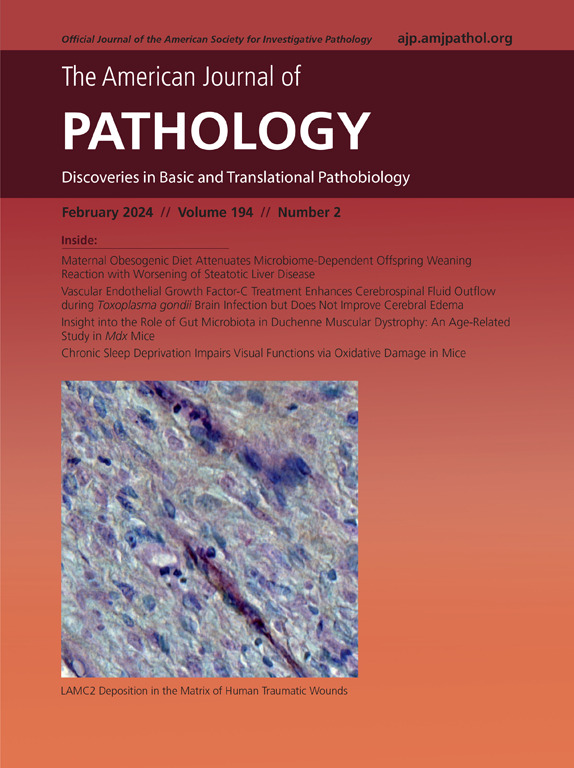A Novel Deep Learning Approach for Analyzing Glomerular Basement Membrane Lesions in a Mouse Model of X-Linked Alport Syndrome
IF 4.7
2区 医学
Q1 PATHOLOGY
引用次数: 0
Abstract
Alport syndrome is a rare kidney disease typically more severe in males due to its X-linked inheritance. However, female patients with heterozygous X-linked Alport syndrome (XLAS) can develop renal failure over time, necessitating accurate pathologic assessment for effective therapy. A key pathologic finding in female patients with XLAS is the mosaic pattern of partial loss of α5 chains of type IV collagen (COL4α5). This study, using a mouse model of XLAS with a nonsense mutation (R471∗) in the Col4a5 gene, analogous to human XLAS, aimed to examine the consistency of this pattern with the glomerular basement membrane (GBM) structure. A modified periodic acid–methenamine silver staining method was developed for clearer GBM visualization. The integrated images from COL4α5-stained fluorescence, periodic acid–methenamine silver, and low-vacuum scanning electron microscopy into a single-slide section and applied supervised deep learning to predict GBM lesions. Results showed significant individual variability in urinary protein levels and histologic lesions. Pathologic parameters, including crescent formation, focal segmental glomerulosclerosis, and the COL4α5/α2 ratio, correlated with clinical parameters like urinary protein and plasma creatinine levels. Integrated low-vacuum scanning electron microscopy analysis revealed dense GBM regions corresponded to areas where COL4α5 was preserved, whereas coarse GBM (basket-weave lesions) occurred in COL4α5-deficient regions. These advanced techniques can enhance biopsy-based diagnosis of Alport syndrome and aid in developing artificial intelligence diagnostic tools for diseases involving basement membrane lesions.

分析 X 连锁阿尔波特综合征小鼠模型肾小球基底膜病变的新型深度学习方法。
阿尔波特综合征是一种罕见的肾脏疾病,由于是 X 连锁遗传,男性患者的病情通常更为严重。然而,患有杂合子X连锁阿尔波特综合征(XLAS)的女性患者随着时间的推移也会出现肾功能衰竭,因此有必要进行准确的病理评估,以便进行有效治疗。女性 XLAS 患者的一个重要病理发现是 IV 型胶原蛋白 α5 链部分缺失的镶嵌模式。本研究利用 Col4a5 基因无义突变(R471*)的 XLAS 小鼠模型(类似于人类 XLAS),旨在研究这种模式与肾小球基底膜(GBM)结构的一致性。为了更清晰地观察肾小球基底膜(GBM),研究人员开发了一种改良的周期性酸-甲酚胺银(PAMS)染色法。将COL4α5染色荧光、PAMS和低真空扫描电子显微镜(LVSEM)的图像整合到单张切片中,并应用有监督的深度学习来预测GBM病变。结果显示,尿蛋白水平和组织学病变存在明显的个体差异。病理参数,包括新月体形成、局灶节段性肾小球硬化和COL4α5/α2比值,与临床参数(如尿蛋白和血浆肌酐水平)相关。综合 LVSEM 分析显示,致密的 GBM 区域与 COL4α5 保留的区域相对应,而粗大的 GBM(篮织病变)则发生在 COL4α5 缺乏的区域。这些先进的技术可提高基于活检的阿尔波特综合征诊断水平,并有助于为涉及基底膜病变的疾病开发人工智能诊断工具。
本文章由计算机程序翻译,如有差异,请以英文原文为准。
求助全文
约1分钟内获得全文
求助全文
来源期刊
CiteScore
11.40
自引率
0.00%
发文量
178
审稿时长
30 days
期刊介绍:
The American Journal of Pathology, official journal of the American Society for Investigative Pathology, published by Elsevier, Inc., seeks high-quality original research reports, reviews, and commentaries related to the molecular and cellular basis of disease. The editors will consider basic, translational, and clinical investigations that directly address mechanisms of pathogenesis or provide a foundation for future mechanistic inquiries. Examples of such foundational investigations include data mining, identification of biomarkers, molecular pathology, and discovery research. Foundational studies that incorporate deep learning and artificial intelligence are also welcome. High priority is given to studies of human disease and relevant experimental models using molecular, cellular, and organismal approaches.

 求助内容:
求助内容: 应助结果提醒方式:
应助结果提醒方式:


